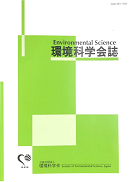
- Issue 6 Pages 241-
- Issue 5 Pages 197-
- Issue 4 Pages 148-
- Issue 3 Pages 89-
- Issue 2 Pages 43-
- Issue 1 Pages 1-
- |<
- <
- 1
- >
- >|
-
Hiroki SATO, Ryuichi TACHIBANA, Hijiri SHIMOJIMA, Keiko IZUMI, Kenji F ...2018Volume 31Issue 4 Pages 148-163
Published: July 31, 2018
Released on J-STAGE: July 31, 2018
JOURNAL FREE ACCESSEvapotranspiration from the Tama River basin (an aquatic resource of Tokyo) has been estimated by meteorological techniques or water balance method, based upon long term measurements. However, no calculation of evapotranspiration exists to differentiate the impact of forest, topography and weather in the basin. Water Cycle Act (established in 2015) demands the quantification of aquatic resources in the future. Therefore, this study estimated the evapotranspiration of the headwaters region of the Tama River using meteorological data observed for 99 years (i.e., 1914–2012) along with six landcover maps made from historical geographic maps and satellite images. The results show that forest area grew from 88.2% in 1910 to 96.0% by 2009, whereas the barren area decreased from 10.9% to 0.6% over the same time period. The quantity of evapotranspiration in the basin averaged 625 mm from 1914 to 2012; this average increased to 600–900 mm during 1986–1989. Evapotranspiration tended to increase with increases in forest area, reductions in relative humidity, and increases in air temperature, especially after 1957 (1957–1989). These trends did not account for the influence of forest trimming in the area. It’s thought that evapotranspiration will increase in the future when the density of evergreen conifers increases.
View full abstractDownload PDF (1983K) -
Kikuo YOSHIDA, Madoka YOSHIDA2018Volume 31Issue 4 Pages 164-177
Published: July 31, 2018
Released on J-STAGE: July 31, 2018
JOURNAL FREE ACCESSMethylcyclohexane (MCH) is one of hydrogen carriers to be used at hydrogen stations refueling to fuel cell vehicles in near future. Although storage and transportation of MCH and its dehydrogenated product, toluene (TOL) are possible under normal temperature and pressure, these substances may be emitted unintentionally from the station into the atmosphere and may cause adverse health effects to residents around the station. In this paper, we estimated atmospheric emission rates of MCH and TOL from a hypothetical hydrogen station and assessed inhalation exposures to both substances of the neighborhood using an atmosphere dispersion model. In parallel, we surveyed existing documents, determined human NOAELs of MCH and TOL for each toxicological endpoints and then selected the nerve, the blood and the kidney as toxicological endpoints of aggregate effect due to combined exposure to both substances. In order to characterize health risk due to combined exposure to MCH and TOL, we calculated hazard indices (HIs) for above three endpoints and also hazard quotients (HQs) for other endpoints. As a result, each HI for the selected effects was less than 0.1 and it is shown that chronically human health risk to the residents caused by MCH and TOL emitted from a hydrogen station will be the level that is not concerned about.
View full abstractDownload PDF (3142K)
-
Takahito NIWA2018Volume 31Issue 4 Pages 178-186
Published: July 31, 2018
Released on J-STAGE: July 31, 2018
JOURNAL FREE ACCESSDownload PDF (480K)
-
Daisuke NUMATA2018Volume 31Issue 4 Pages 187-196
Published: July 31, 2018
Released on J-STAGE: July 31, 2018
JOURNAL FREE ACCESSMore retailers in Japan have recently collected used PET bottles. These store collections face many problems such as the burden on retailers and the relationship with municipal governments. On the other hand, in Sweden, mandatory deposit-refund systems collect used PET bottles in stores with the same types of reverse vending machines as those used in Japan. This paper aims to clarify the characteristics of store collection in Japan, from the structural and historical perspective, compared to that in Sweden, in terms of PET bottles. This clarification will create a basis for future Japanese store collection.
This paper suggests solutions to Japanese store collection problems: Firstly, the store collection should include a scheme such as handling fees and charging deposits on a purchase phase, in order to decrease the burden on retailers. Secondly, stores should collect more recyclables, and municipalities should help households and difficult-to-reach areas with store collection. Thirdly, sharing a policy target with a variety of stakeholders for socially efficient use of store collection would be valuable.
View full abstractDownload PDF (512K)
- |<
- <
- 1
- >
- >|